Project Report: Risk Strategies of Singapore Airlines and Qantas
VerifiedAdded on 2023/01/19
|10
|1835
|59
Report
AI Summary
This report delves into the application of risk management concepts within the aviation industry, specifically focusing on Singapore Airlines and Qantas. It begins with an examination of risk assessment strategies employed by these airlines, including the use of strategic maps, risk scorecards, and balance scorecards. The report then presents a case study analysis of the strategies and plans implemented by both airlines to mitigate various risks, such as operational, people, and data security threats. The report highlights Singapore Airlines' risk management committees and their processes for identifying, evaluating, and prioritizing risks. Finally, the report offers recommendations, including the development of business continuity plans and effective communication strategies, to enhance risk management practices within the aviation sector. The analysis draws upon scholarly journal articles to support the findings and recommendations.

PROJECT MANAGEMENT
Paraphrase This Document
Need a fresh take? Get an instant paraphrase of this document with our AI Paraphraser
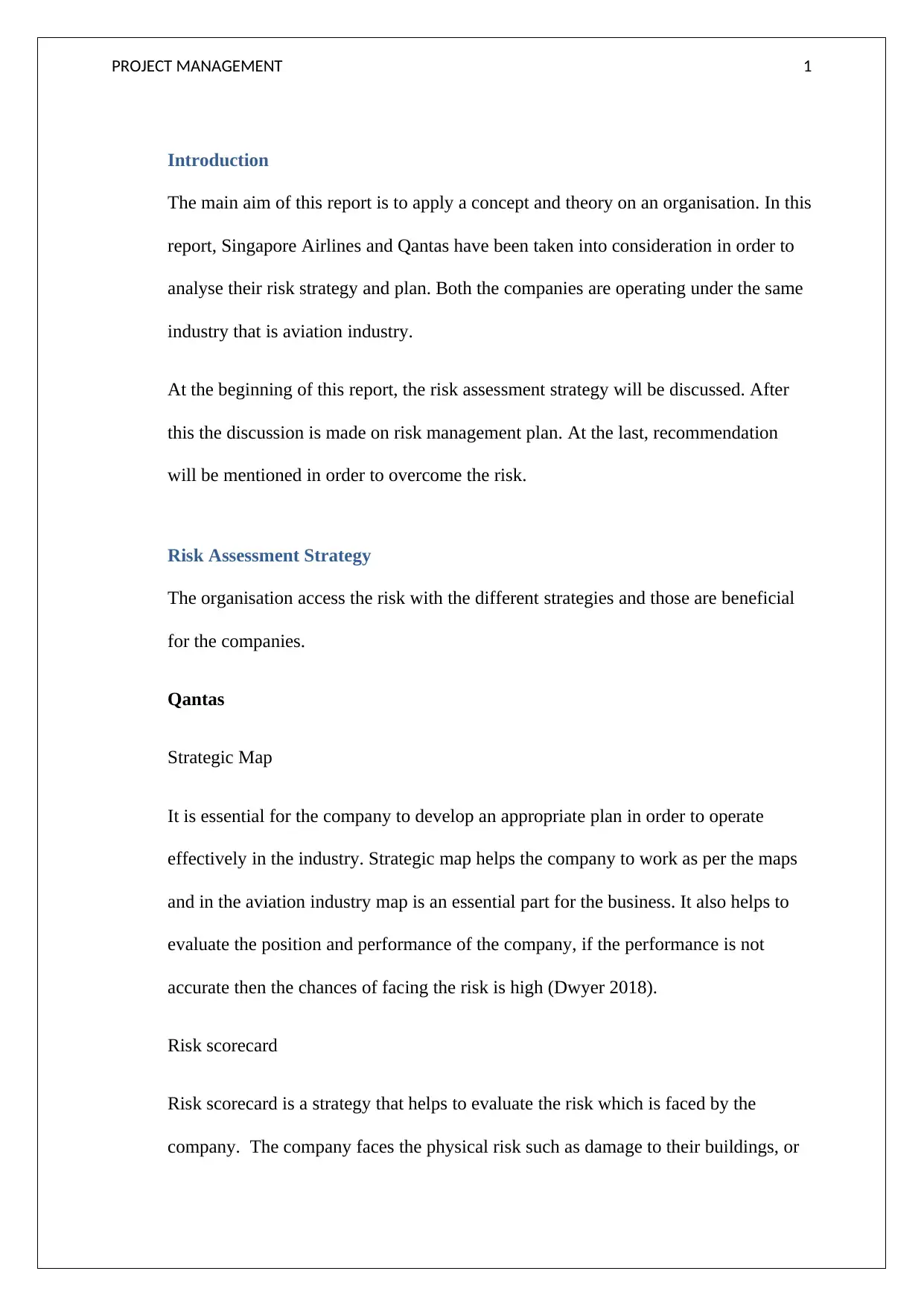
PROJECT MANAGEMENT 1
Introduction
The main aim of this report is to apply a concept and theory on an organisation. In this
report, Singapore Airlines and Qantas have been taken into consideration in order to
analyse their risk strategy and plan. Both the companies are operating under the same
industry that is aviation industry.
At the beginning of this report, the risk assessment strategy will be discussed. After
this the discussion is made on risk management plan. At the last, recommendation
will be mentioned in order to overcome the risk.
Risk Assessment Strategy
The organisation access the risk with the different strategies and those are beneficial
for the companies.
Qantas
Strategic Map
It is essential for the company to develop an appropriate plan in order to operate
effectively in the industry. Strategic map helps the company to work as per the maps
and in the aviation industry map is an essential part for the business. It also helps to
evaluate the position and performance of the company, if the performance is not
accurate then the chances of facing the risk is high (Dwyer 2018).
Risk scorecard
Risk scorecard is a strategy that helps to evaluate the risk which is faced by the
company. The company faces the physical risk such as damage to their buildings, or
Introduction
The main aim of this report is to apply a concept and theory on an organisation. In this
report, Singapore Airlines and Qantas have been taken into consideration in order to
analyse their risk strategy and plan. Both the companies are operating under the same
industry that is aviation industry.
At the beginning of this report, the risk assessment strategy will be discussed. After
this the discussion is made on risk management plan. At the last, recommendation
will be mentioned in order to overcome the risk.
Risk Assessment Strategy
The organisation access the risk with the different strategies and those are beneficial
for the companies.
Qantas
Strategic Map
It is essential for the company to develop an appropriate plan in order to operate
effectively in the industry. Strategic map helps the company to work as per the maps
and in the aviation industry map is an essential part for the business. It also helps to
evaluate the position and performance of the company, if the performance is not
accurate then the chances of facing the risk is high (Dwyer 2018).
Risk scorecard
Risk scorecard is a strategy that helps to evaluate the risk which is faced by the
company. The company faces the physical risk such as damage to their buildings, or
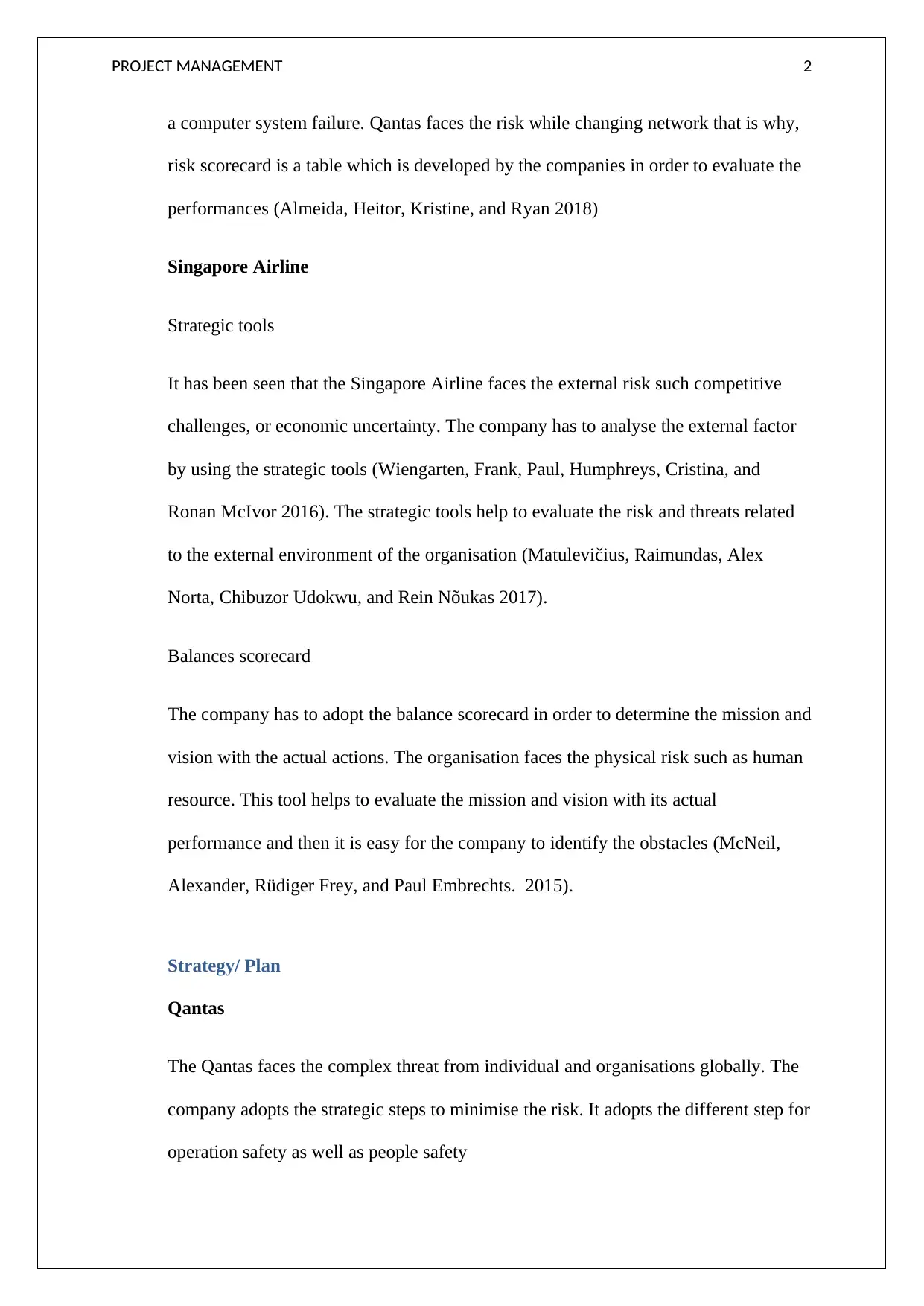
PROJECT MANAGEMENT 2
a computer system failure. Qantas faces the risk while changing network that is why,
risk scorecard is a table which is developed by the companies in order to evaluate the
performances (Almeida, Heitor, Kristine, and Ryan 2018)
Singapore Airline
Strategic tools
It has been seen that the Singapore Airline faces the external risk such competitive
challenges, or economic uncertainty. The company has to analyse the external factor
by using the strategic tools (Wiengarten, Frank, Paul, Humphreys, Cristina, and
Ronan McIvor 2016). The strategic tools help to evaluate the risk and threats related
to the external environment of the organisation (Matulevičius, Raimundas, Alex
Norta, Chibuzor Udokwu, and Rein Nõukas 2017).
Balances scorecard
The company has to adopt the balance scorecard in order to determine the mission and
vision with the actual actions. The organisation faces the physical risk such as human
resource. This tool helps to evaluate the mission and vision with its actual
performance and then it is easy for the company to identify the obstacles (McNeil,
Alexander, Rüdiger Frey, and Paul Embrechts. 2015).
Strategy/ Plan
Qantas
The Qantas faces the complex threat from individual and organisations globally. The
company adopts the strategic steps to minimise the risk. It adopts the different step for
operation safety as well as people safety
a computer system failure. Qantas faces the risk while changing network that is why,
risk scorecard is a table which is developed by the companies in order to evaluate the
performances (Almeida, Heitor, Kristine, and Ryan 2018)
Singapore Airline
Strategic tools
It has been seen that the Singapore Airline faces the external risk such competitive
challenges, or economic uncertainty. The company has to analyse the external factor
by using the strategic tools (Wiengarten, Frank, Paul, Humphreys, Cristina, and
Ronan McIvor 2016). The strategic tools help to evaluate the risk and threats related
to the external environment of the organisation (Matulevičius, Raimundas, Alex
Norta, Chibuzor Udokwu, and Rein Nõukas 2017).
Balances scorecard
The company has to adopt the balance scorecard in order to determine the mission and
vision with the actual actions. The organisation faces the physical risk such as human
resource. This tool helps to evaluate the mission and vision with its actual
performance and then it is easy for the company to identify the obstacles (McNeil,
Alexander, Rüdiger Frey, and Paul Embrechts. 2015).
Strategy/ Plan
Qantas
The Qantas faces the complex threat from individual and organisations globally. The
company adopts the strategic steps to minimise the risk. It adopts the different step for
operation safety as well as people safety
⊘ This is a preview!⊘
Do you want full access?
Subscribe today to unlock all pages.

Trusted by 1+ million students worldwide
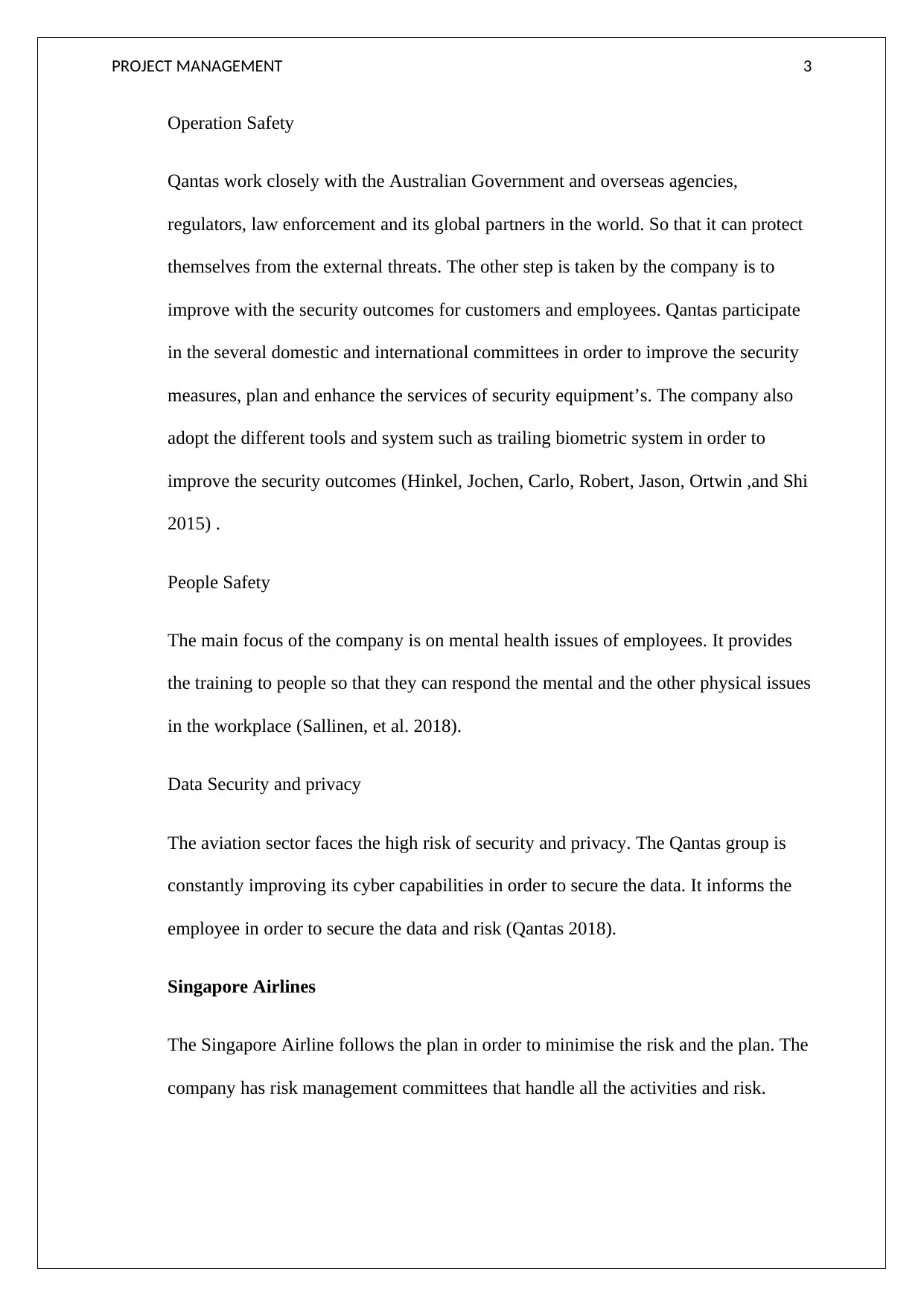
PROJECT MANAGEMENT 3
Operation Safety
Qantas work closely with the Australian Government and overseas agencies,
regulators, law enforcement and its global partners in the world. So that it can protect
themselves from the external threats. The other step is taken by the company is to
improve with the security outcomes for customers and employees. Qantas participate
in the several domestic and international committees in order to improve the security
measures, plan and enhance the services of security equipment’s. The company also
adopt the different tools and system such as trailing biometric system in order to
improve the security outcomes (Hinkel, Jochen, Carlo, Robert, Jason, Ortwin ,and Shi
2015) .
People Safety
The main focus of the company is on mental health issues of employees. It provides
the training to people so that they can respond the mental and the other physical issues
in the workplace (Sallinen, et al. 2018).
Data Security and privacy
The aviation sector faces the high risk of security and privacy. The Qantas group is
constantly improving its cyber capabilities in order to secure the data. It informs the
employee in order to secure the data and risk (Qantas 2018).
Singapore Airlines
The Singapore Airline follows the plan in order to minimise the risk and the plan. The
company has risk management committees that handle all the activities and risk.
Operation Safety
Qantas work closely with the Australian Government and overseas agencies,
regulators, law enforcement and its global partners in the world. So that it can protect
themselves from the external threats. The other step is taken by the company is to
improve with the security outcomes for customers and employees. Qantas participate
in the several domestic and international committees in order to improve the security
measures, plan and enhance the services of security equipment’s. The company also
adopt the different tools and system such as trailing biometric system in order to
improve the security outcomes (Hinkel, Jochen, Carlo, Robert, Jason, Ortwin ,and Shi
2015) .
People Safety
The main focus of the company is on mental health issues of employees. It provides
the training to people so that they can respond the mental and the other physical issues
in the workplace (Sallinen, et al. 2018).
Data Security and privacy
The aviation sector faces the high risk of security and privacy. The Qantas group is
constantly improving its cyber capabilities in order to secure the data. It informs the
employee in order to secure the data and risk (Qantas 2018).
Singapore Airlines
The Singapore Airline follows the plan in order to minimise the risk and the plan. The
company has risk management committees that handle all the activities and risk.
Paraphrase This Document
Need a fresh take? Get an instant paraphrase of this document with our AI Paraphraser
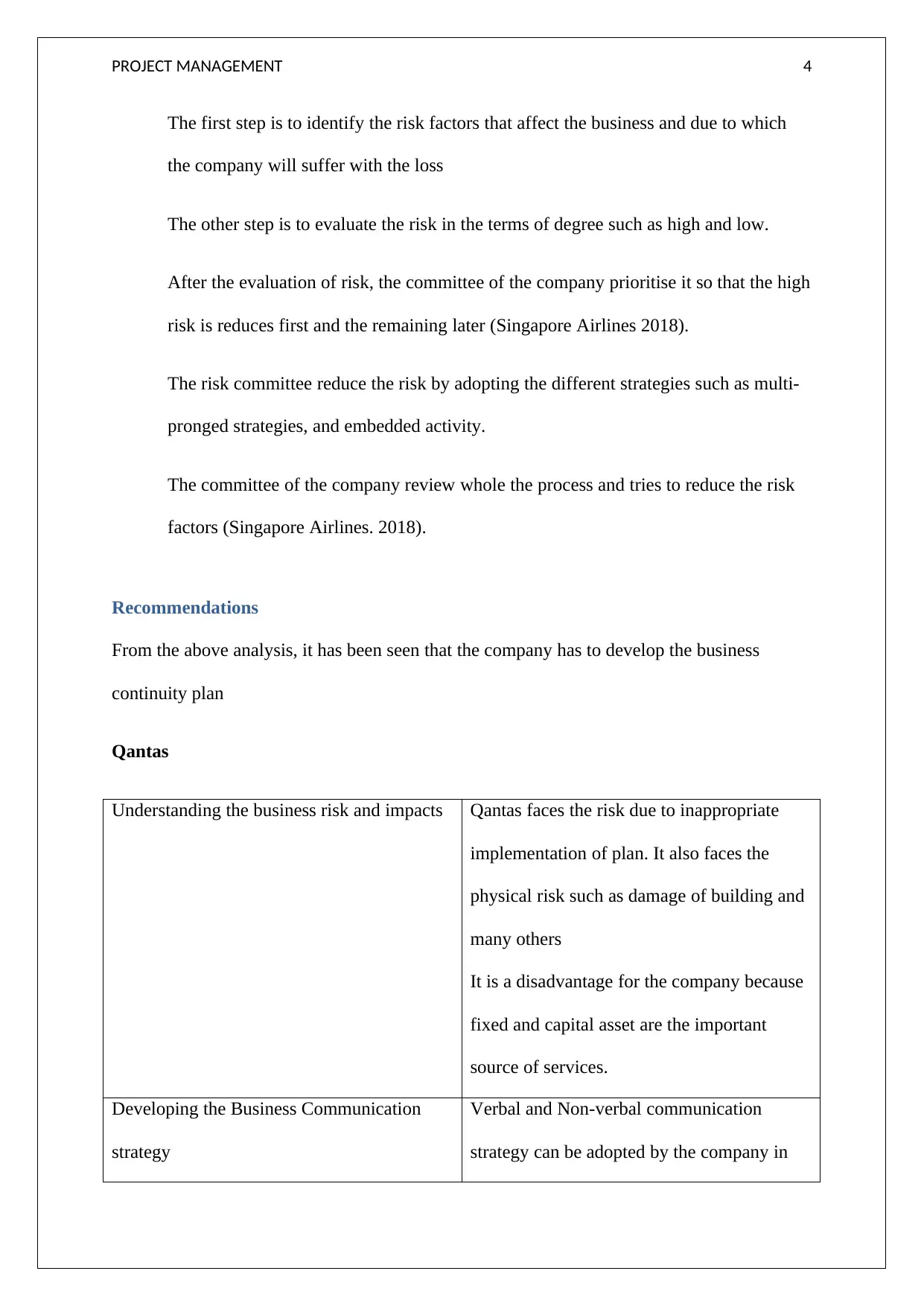
PROJECT MANAGEMENT 4
The first step is to identify the risk factors that affect the business and due to which
the company will suffer with the loss
The other step is to evaluate the risk in the terms of degree such as high and low.
After the evaluation of risk, the committee of the company prioritise it so that the high
risk is reduces first and the remaining later (Singapore Airlines 2018).
The risk committee reduce the risk by adopting the different strategies such as multi-
pronged strategies, and embedded activity.
The committee of the company review whole the process and tries to reduce the risk
factors (Singapore Airlines. 2018).
Recommendations
From the above analysis, it has been seen that the company has to develop the business
continuity plan
Qantas
Understanding the business risk and impacts Qantas faces the risk due to inappropriate
implementation of plan. It also faces the
physical risk such as damage of building and
many others
It is a disadvantage for the company because
fixed and capital asset are the important
source of services.
Developing the Business Communication
strategy
Verbal and Non-verbal communication
strategy can be adopted by the company in
The first step is to identify the risk factors that affect the business and due to which
the company will suffer with the loss
The other step is to evaluate the risk in the terms of degree such as high and low.
After the evaluation of risk, the committee of the company prioritise it so that the high
risk is reduces first and the remaining later (Singapore Airlines 2018).
The risk committee reduce the risk by adopting the different strategies such as multi-
pronged strategies, and embedded activity.
The committee of the company review whole the process and tries to reduce the risk
factors (Singapore Airlines. 2018).
Recommendations
From the above analysis, it has been seen that the company has to develop the business
continuity plan
Qantas
Understanding the business risk and impacts Qantas faces the risk due to inappropriate
implementation of plan. It also faces the
physical risk such as damage of building and
many others
It is a disadvantage for the company because
fixed and capital asset are the important
source of services.
Developing the Business Communication
strategy
Verbal and Non-verbal communication
strategy can be adopted by the company in
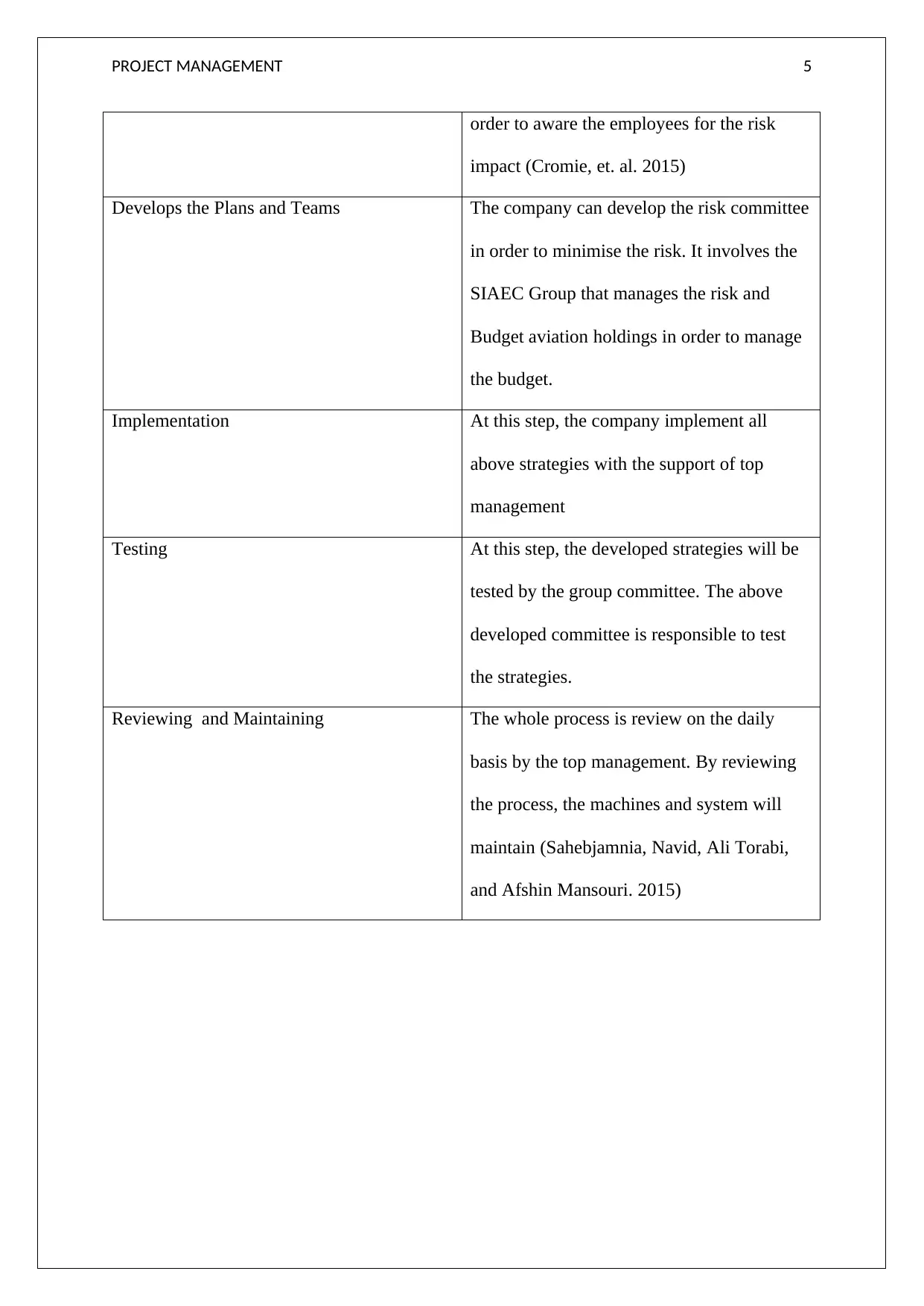
PROJECT MANAGEMENT 5
order to aware the employees for the risk
impact (Cromie, et. al. 2015)
Develops the Plans and Teams The company can develop the risk committee
in order to minimise the risk. It involves the
SIAEC Group that manages the risk and
Budget aviation holdings in order to manage
the budget.
Implementation At this step, the company implement all
above strategies with the support of top
management
Testing At this step, the developed strategies will be
tested by the group committee. The above
developed committee is responsible to test
the strategies.
Reviewing and Maintaining The whole process is review on the daily
basis by the top management. By reviewing
the process, the machines and system will
maintain (Sahebjamnia, Navid, Ali Torabi,
and Afshin Mansouri. 2015)
order to aware the employees for the risk
impact (Cromie, et. al. 2015)
Develops the Plans and Teams The company can develop the risk committee
in order to minimise the risk. It involves the
SIAEC Group that manages the risk and
Budget aviation holdings in order to manage
the budget.
Implementation At this step, the company implement all
above strategies with the support of top
management
Testing At this step, the developed strategies will be
tested by the group committee. The above
developed committee is responsible to test
the strategies.
Reviewing and Maintaining The whole process is review on the daily
basis by the top management. By reviewing
the process, the machines and system will
maintain (Sahebjamnia, Navid, Ali Torabi,
and Afshin Mansouri. 2015)
⊘ This is a preview!⊘
Do you want full access?
Subscribe today to unlock all pages.

Trusted by 1+ million students worldwide
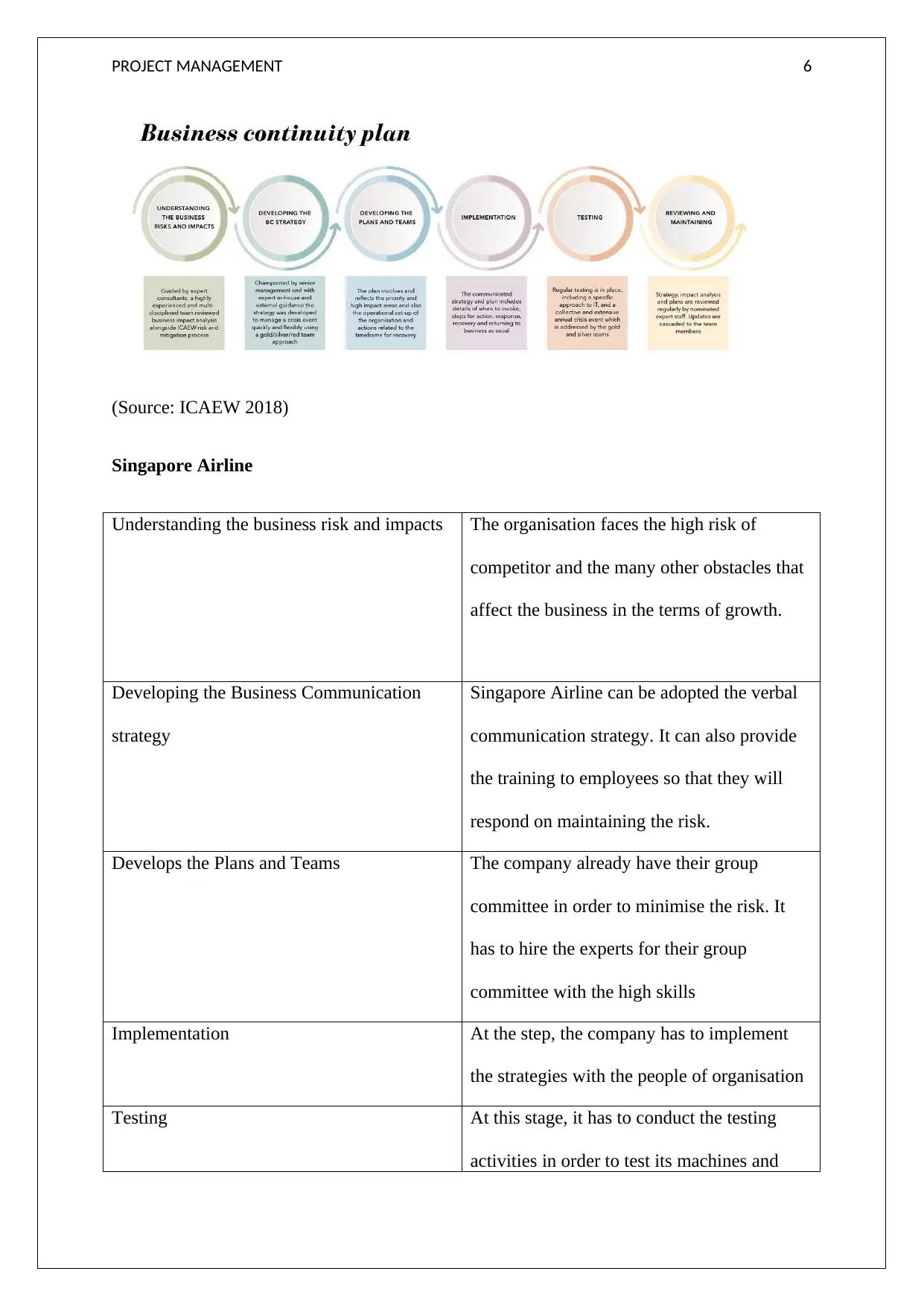
PROJECT MANAGEMENT 6
(Source: ICAEW 2018)
Singapore Airline
Understanding the business risk and impacts The organisation faces the high risk of
competitor and the many other obstacles that
affect the business in the terms of growth.
Developing the Business Communication
strategy
Singapore Airline can be adopted the verbal
communication strategy. It can also provide
the training to employees so that they will
respond on maintaining the risk.
Develops the Plans and Teams The company already have their group
committee in order to minimise the risk. It
has to hire the experts for their group
committee with the high skills
Implementation At the step, the company has to implement
the strategies with the people of organisation
Testing At this stage, it has to conduct the testing
activities in order to test its machines and
(Source: ICAEW 2018)
Singapore Airline
Understanding the business risk and impacts The organisation faces the high risk of
competitor and the many other obstacles that
affect the business in the terms of growth.
Developing the Business Communication
strategy
Singapore Airline can be adopted the verbal
communication strategy. It can also provide
the training to employees so that they will
respond on maintaining the risk.
Develops the Plans and Teams The company already have their group
committee in order to minimise the risk. It
has to hire the experts for their group
committee with the high skills
Implementation At the step, the company has to implement
the strategies with the people of organisation
Testing At this stage, it has to conduct the testing
activities in order to test its machines and
Paraphrase This Document
Need a fresh take? Get an instant paraphrase of this document with our AI Paraphraser
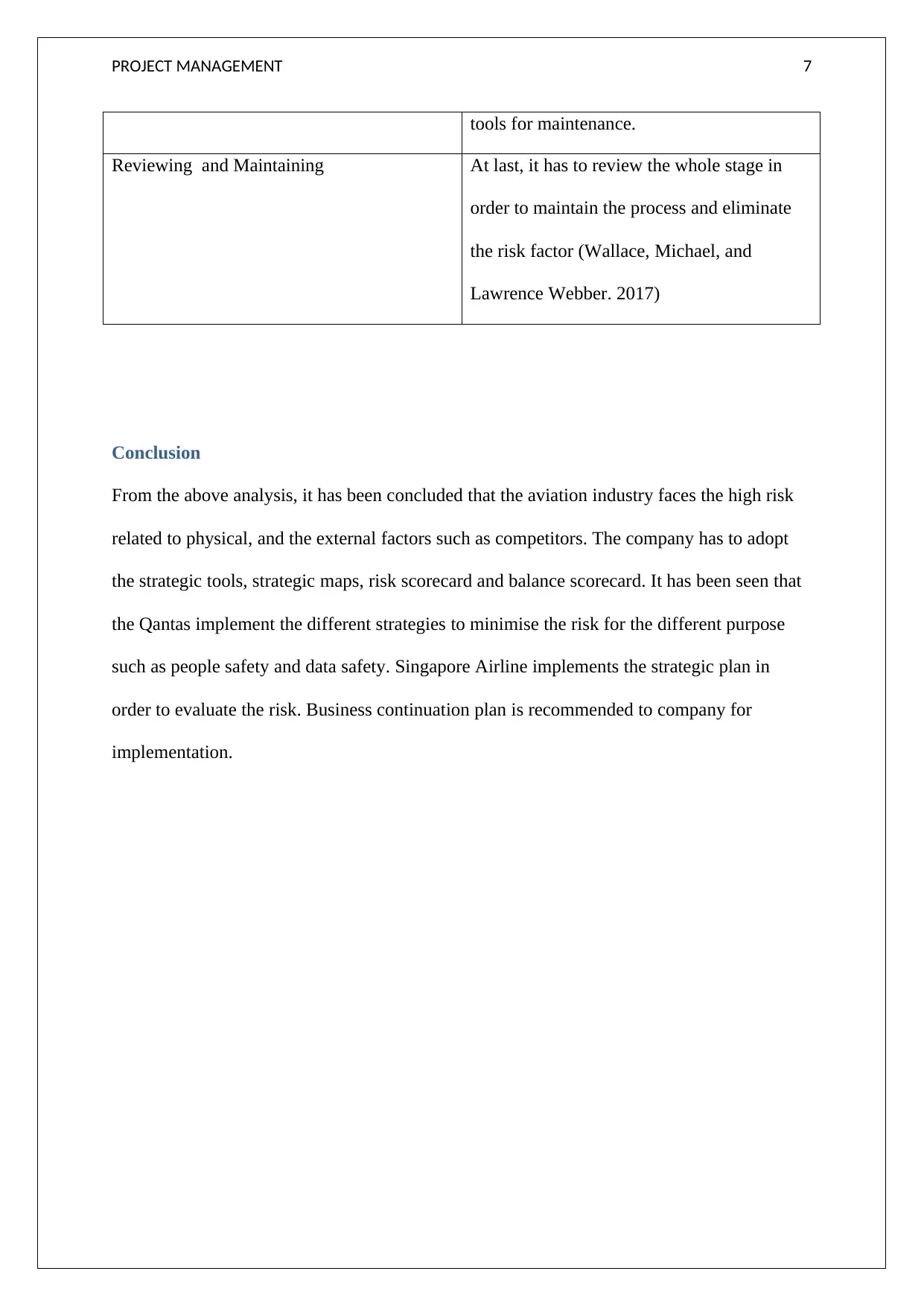
PROJECT MANAGEMENT 7
tools for maintenance.
Reviewing and Maintaining At last, it has to review the whole stage in
order to maintain the process and eliminate
the risk factor (Wallace, Michael, and
Lawrence Webber. 2017)
Conclusion
From the above analysis, it has been concluded that the aviation industry faces the high risk
related to physical, and the external factors such as competitors. The company has to adopt
the strategic tools, strategic maps, risk scorecard and balance scorecard. It has been seen that
the Qantas implement the different strategies to minimise the risk for the different purpose
such as people safety and data safety. Singapore Airline implements the strategic plan in
order to evaluate the risk. Business continuation plan is recommended to company for
implementation.
tools for maintenance.
Reviewing and Maintaining At last, it has to review the whole stage in
order to maintain the process and eliminate
the risk factor (Wallace, Michael, and
Lawrence Webber. 2017)
Conclusion
From the above analysis, it has been concluded that the aviation industry faces the high risk
related to physical, and the external factors such as competitors. The company has to adopt
the strategic tools, strategic maps, risk scorecard and balance scorecard. It has been seen that
the Qantas implement the different strategies to minimise the risk for the different purpose
such as people safety and data safety. Singapore Airline implements the strategic plan in
order to evaluate the risk. Business continuation plan is recommended to company for
implementation.
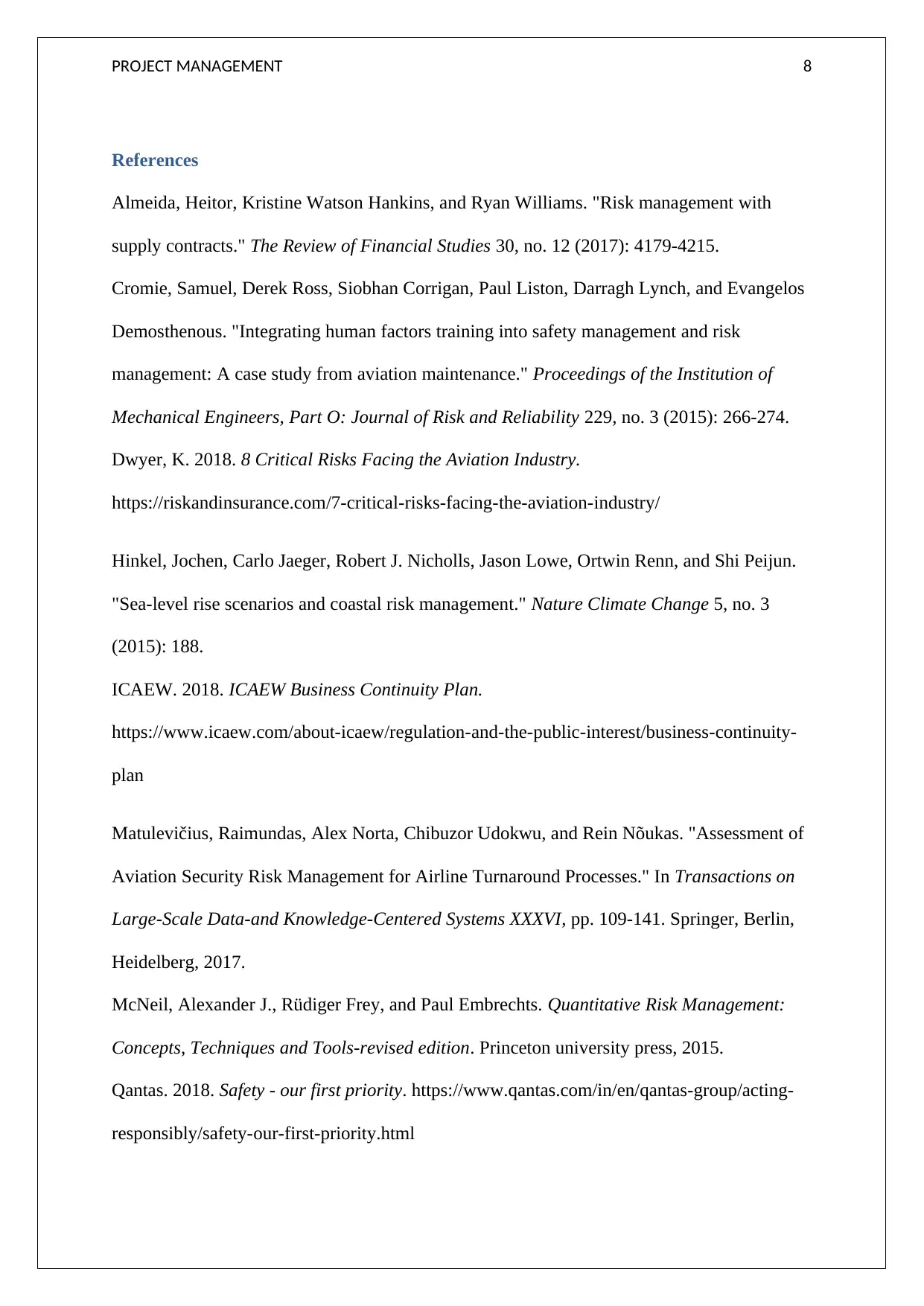
PROJECT MANAGEMENT 8
References
Almeida, Heitor, Kristine Watson Hankins, and Ryan Williams. "Risk management with
supply contracts." The Review of Financial Studies 30, no. 12 (2017): 4179-4215.
Cromie, Samuel, Derek Ross, Siobhan Corrigan, Paul Liston, Darragh Lynch, and Evangelos
Demosthenous. "Integrating human factors training into safety management and risk
management: A case study from aviation maintenance." Proceedings of the Institution of
Mechanical Engineers, Part O: Journal of Risk and Reliability 229, no. 3 (2015): 266-274.
Dwyer, K. 2018. 8 Critical Risks Facing the Aviation Industry.
https://riskandinsurance.com/7-critical-risks-facing-the-aviation-industry/
Hinkel, Jochen, Carlo Jaeger, Robert J. Nicholls, Jason Lowe, Ortwin Renn, and Shi Peijun.
"Sea-level rise scenarios and coastal risk management." Nature Climate Change 5, no. 3
(2015): 188.
ICAEW. 2018. ICAEW Business Continuity Plan.
https://www.icaew.com/about-icaew/regulation-and-the-public-interest/business-continuity-
plan
Matulevičius, Raimundas, Alex Norta, Chibuzor Udokwu, and Rein Nõukas. "Assessment of
Aviation Security Risk Management for Airline Turnaround Processes." In Transactions on
Large-Scale Data-and Knowledge-Centered Systems XXXVI, pp. 109-141. Springer, Berlin,
Heidelberg, 2017.
McNeil, Alexander J., Rüdiger Frey, and Paul Embrechts. Quantitative Risk Management:
Concepts, Techniques and Tools-revised edition. Princeton university press, 2015.
Qantas. 2018. Safety - our first priority. https://www.qantas.com/in/en/qantas-group/acting-
responsibly/safety-our-first-priority.html
References
Almeida, Heitor, Kristine Watson Hankins, and Ryan Williams. "Risk management with
supply contracts." The Review of Financial Studies 30, no. 12 (2017): 4179-4215.
Cromie, Samuel, Derek Ross, Siobhan Corrigan, Paul Liston, Darragh Lynch, and Evangelos
Demosthenous. "Integrating human factors training into safety management and risk
management: A case study from aviation maintenance." Proceedings of the Institution of
Mechanical Engineers, Part O: Journal of Risk and Reliability 229, no. 3 (2015): 266-274.
Dwyer, K. 2018. 8 Critical Risks Facing the Aviation Industry.
https://riskandinsurance.com/7-critical-risks-facing-the-aviation-industry/
Hinkel, Jochen, Carlo Jaeger, Robert J. Nicholls, Jason Lowe, Ortwin Renn, and Shi Peijun.
"Sea-level rise scenarios and coastal risk management." Nature Climate Change 5, no. 3
(2015): 188.
ICAEW. 2018. ICAEW Business Continuity Plan.
https://www.icaew.com/about-icaew/regulation-and-the-public-interest/business-continuity-
plan
Matulevičius, Raimundas, Alex Norta, Chibuzor Udokwu, and Rein Nõukas. "Assessment of
Aviation Security Risk Management for Airline Turnaround Processes." In Transactions on
Large-Scale Data-and Knowledge-Centered Systems XXXVI, pp. 109-141. Springer, Berlin,
Heidelberg, 2017.
McNeil, Alexander J., Rüdiger Frey, and Paul Embrechts. Quantitative Risk Management:
Concepts, Techniques and Tools-revised edition. Princeton university press, 2015.
Qantas. 2018. Safety - our first priority. https://www.qantas.com/in/en/qantas-group/acting-
responsibly/safety-our-first-priority.html
⊘ This is a preview!⊘
Do you want full access?
Subscribe today to unlock all pages.

Trusted by 1+ million students worldwide
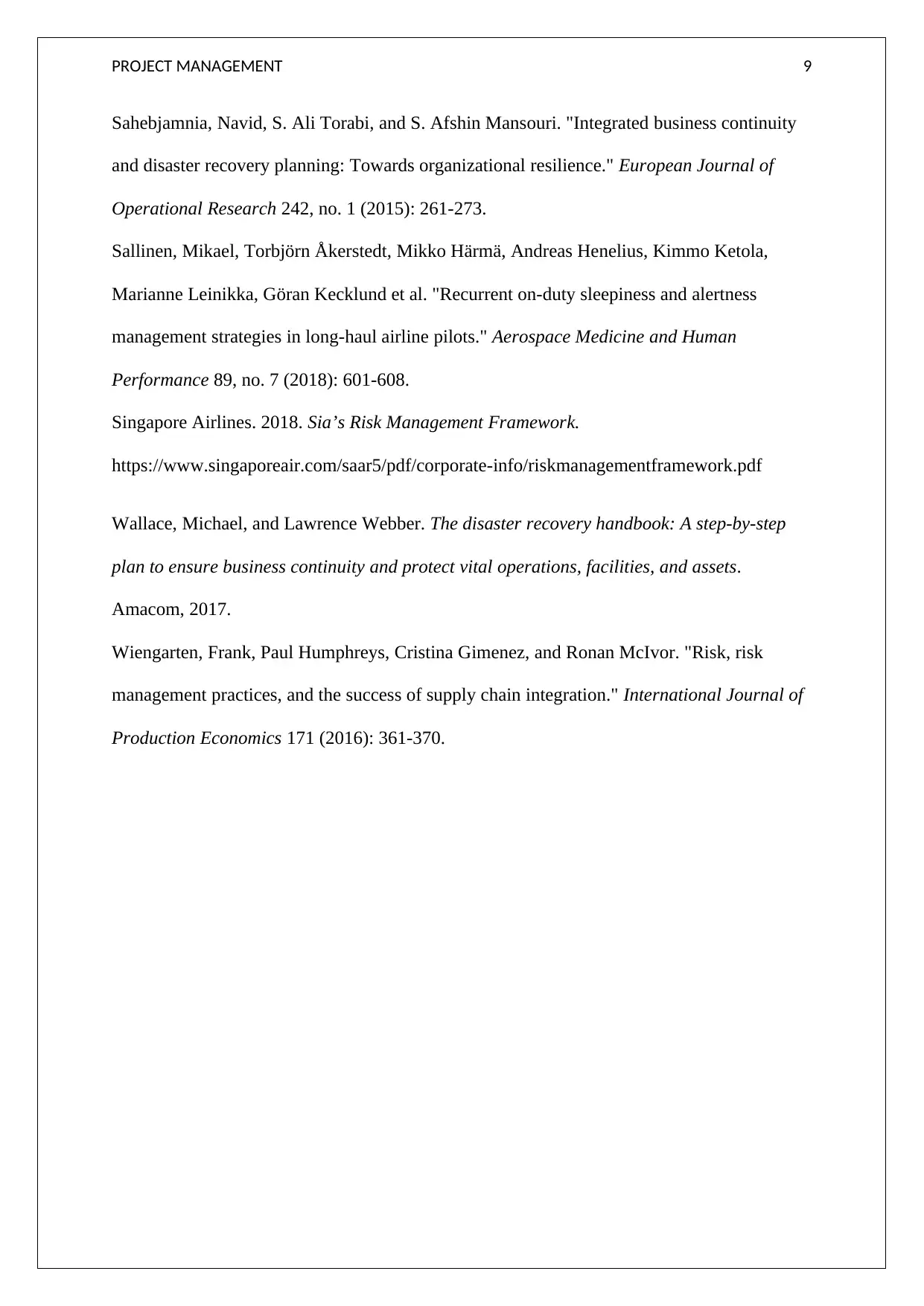
PROJECT MANAGEMENT 9
Sahebjamnia, Navid, S. Ali Torabi, and S. Afshin Mansouri. "Integrated business continuity
and disaster recovery planning: Towards organizational resilience." European Journal of
Operational Research 242, no. 1 (2015): 261-273.
Sallinen, Mikael, Torbjörn Åkerstedt, Mikko Härmä, Andreas Henelius, Kimmo Ketola,
Marianne Leinikka, Göran Kecklund et al. "Recurrent on-duty sleepiness and alertness
management strategies in long-haul airline pilots." Aerospace Medicine and Human
Performance 89, no. 7 (2018): 601-608.
Singapore Airlines. 2018. Sia’s Risk Management Framework.
https://www.singaporeair.com/saar5/pdf/corporate-info/riskmanagementframework.pdf
Wallace, Michael, and Lawrence Webber. The disaster recovery handbook: A step-by-step
plan to ensure business continuity and protect vital operations, facilities, and assets.
Amacom, 2017.
Wiengarten, Frank, Paul Humphreys, Cristina Gimenez, and Ronan McIvor. "Risk, risk
management practices, and the success of supply chain integration." International Journal of
Production Economics 171 (2016): 361-370.
Sahebjamnia, Navid, S. Ali Torabi, and S. Afshin Mansouri. "Integrated business continuity
and disaster recovery planning: Towards organizational resilience." European Journal of
Operational Research 242, no. 1 (2015): 261-273.
Sallinen, Mikael, Torbjörn Åkerstedt, Mikko Härmä, Andreas Henelius, Kimmo Ketola,
Marianne Leinikka, Göran Kecklund et al. "Recurrent on-duty sleepiness and alertness
management strategies in long-haul airline pilots." Aerospace Medicine and Human
Performance 89, no. 7 (2018): 601-608.
Singapore Airlines. 2018. Sia’s Risk Management Framework.
https://www.singaporeair.com/saar5/pdf/corporate-info/riskmanagementframework.pdf
Wallace, Michael, and Lawrence Webber. The disaster recovery handbook: A step-by-step
plan to ensure business continuity and protect vital operations, facilities, and assets.
Amacom, 2017.
Wiengarten, Frank, Paul Humphreys, Cristina Gimenez, and Ronan McIvor. "Risk, risk
management practices, and the success of supply chain integration." International Journal of
Production Economics 171 (2016): 361-370.
1 out of 10
Related Documents
Your All-in-One AI-Powered Toolkit for Academic Success.
+13062052269
info@desklib.com
Available 24*7 on WhatsApp / Email
![[object Object]](/_next/static/media/star-bottom.7253800d.svg)
Unlock your academic potential
Copyright © 2020–2025 A2Z Services. All Rights Reserved. Developed and managed by ZUCOL.





